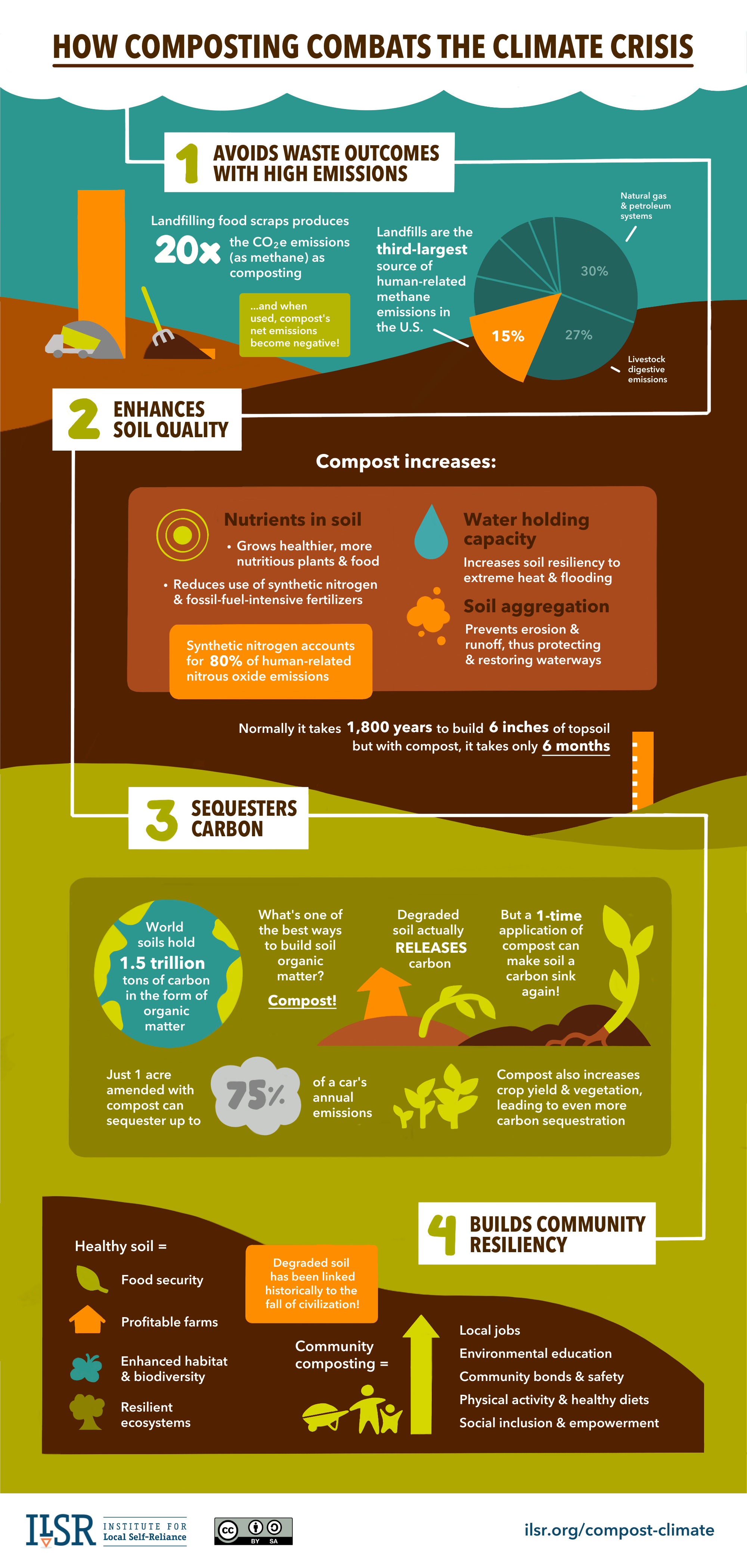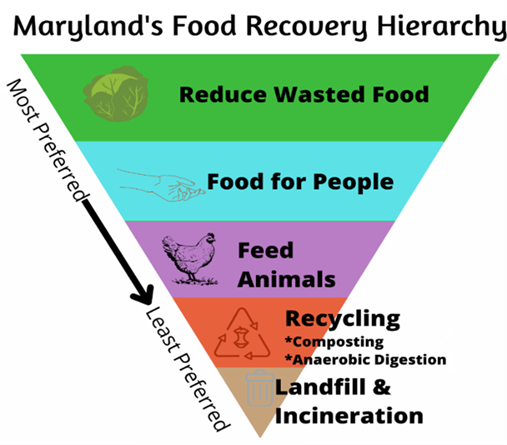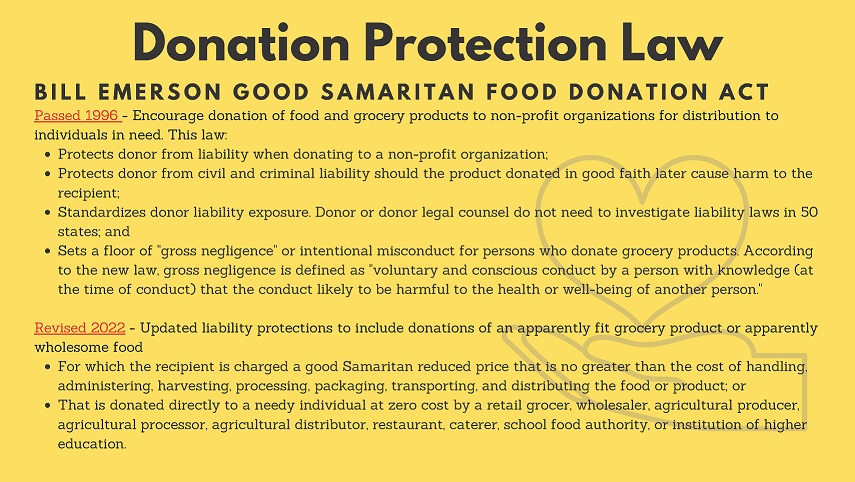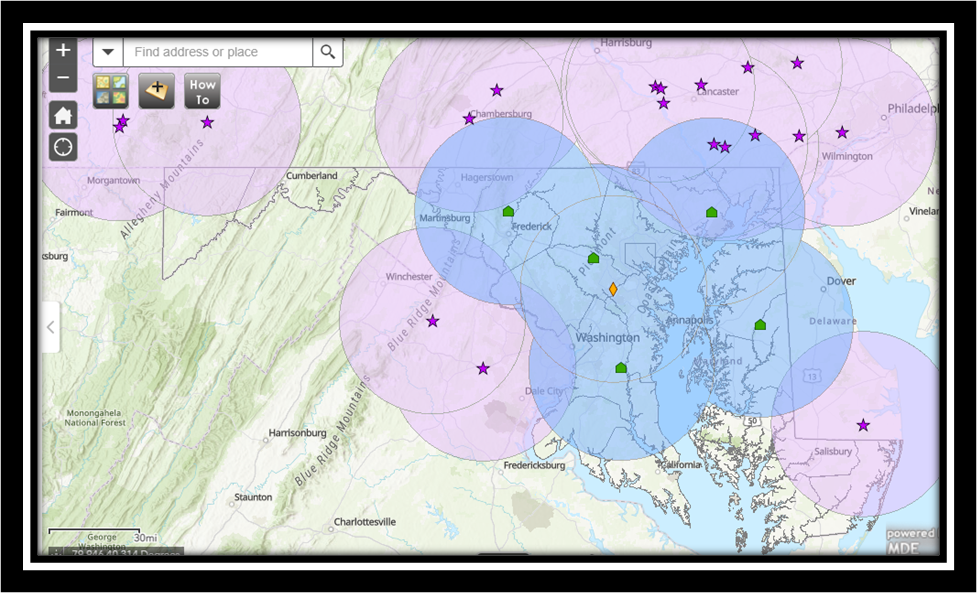Food is a valuable resource. Wasting edible and inedible food also wastes the water, energy, labor, pesticides, fertilizers, and land used to make and transport the food. Below are resources to learn more about food waste reduction in Maryland. In 2021, the Maryland General Assembly passed
House Bill 264/Senate Bill 483 entitled Solid Waste Management – Organics Recycling and Waste Diversion – Food Residuals, which requires certain entities that generate food residuals to separate the food residuals from other solid waste and ensure that the food residuals are diverted from final disposal in refuse disposal systems. The law follows the traditional food recovery hierarchy - prevent waste before it occurs, feed people, feed animals, and recycle non-edible food residuals. The focus is to reduce the amount of greenhouse gasses emitted from landfills; provide edible food to people at a free or lower cost; and improve Maryland's soils. The law does not require food diversion for private residences.
Announcements
Deadline for organic recycling - Food Residuals Diversion Law Reminder 
Presentation and
Recording from January 19, 2023 Webinar on new regulations COMAR 26.04.13 Food Residuals-Organics Recycling and Waste Diversion
Determination of Applicability of the Food Residuals Diversion Requirement(Revised)
Determinación de la aplicabilidad del requisito de desviación de residuos alimenticios (Revisado)
New Food Residuals Diversion Regulations (COMAR 26.04.13)
On
December 06, 2022, the Secretary of the Environment adopted new regulations under Code of Maryland Regulations (COMAR) 26.04.13 Food Residuals - Organics Recycling and Waste Diversion.
The regulations implement House Bill 264/Senate Bill 483 of 2021, and establish certain regulatory conditions for persons required to divert food residuals from final disposal in a refuse disposal system.
The new regulations become effective on December 26, 2022.
The following are helpful documents regarding the new regulations:
Why is it important to reduce the amount of wasted food?
|
In 2020, approximately 774,400 tons of food waste was disposed of in Maryland in landfills and incinerators. Only 167,200 tons were recycled at organic recycling facilities such as composters and anaerobic digesters. It takes a lot of money, water, and energy to produce our nation’s food supply, and by disposing of wasted food into landfills and incinerators, all that money, water and energy is lost. Decomposition of food waste in a landfill leads to the generation of greenhouse gases, such as methane. Methane is one of the chief gases contributing to climate change. In addition, food waste takes up a large amount of space in a landfill, resulting in the filling and closing of landfills at a faster pace. If burned in an incinerator, gases such as carbon dioxide and nitrous oxide contribute to increased air pollution.
Much of the food that is discarded into the waste stream is perfectly fine and edible. This food would best be used to help feed people in need through donations to food rescue organizations or community groups. Excess edible food may also be used for animal feed on farms or in pet food. Other food waste can be sent to an organics recycling facility for composting or anaerobic digestion. This list is just a smattering of reasons why organics recycling is beneficial to the environment.
| 
|
-
Organic waste in landfills generates, methane, a potent greenhouse gas. Composting wasted food and other organics significantly reduces methane, and anaerobic digesting the material captures methane for beneficial reuse.
- Compost and digestate reduce and in some cases eliminate the need for chemical fertilizers.
- Compost and digestate promote higher yields of agricultural crops.
- Compost can aide in reforestation, wetlands restoration, and habitat revitalization efforts by improving contaminated, compacted, and marginal soils.
- Compost may be used to remediate soils contaminated by hazardous waste in a cost effective manner.
- Compost can provide cost savings over conventional soil, water, and air pollution remediation technologies, where applicable.
- Digestate alleviates soil compaction.
- Compost and digestate enhance water retention in soils, reducing need for irrigation.
- Compost provides carbon sequestration.
- Biogas produced from anaerobic digestion can be used for heat and/or energy generation, or processed into natural gas for use as vehicle fuel.
Who is affected by the food residuals diversion law?
- How do you know if this law applies to your facility?
- MDE has prepared a document called “Determination of Applicability of the Food Residuals Diversion Requirement” [ENG /
ESP] that describes the entities that may be required to divert their food residuals under the law.
-
How to estimate food residuals quantities (sector estimates)?
-
MDE has prepared a document called “Maryland Food Residual Generation Factor Estimates by Industry Sector” [ENG /
ESP] that explains how various industry types can estimate the amount of food residuals they generate.
-
What documentation should be maintained at your facility?
-
To maintain compliance with the law, the Department developed a sample list of items to be maintained on-site for ANY facility where food residuals are generated. See "Appendix A" in " Determination of Applicability of the Food Residuals Diversion Requirement"
ENG /ESP
-
Waivers application information
-
If identified as a person under this law, and it is in your belief that compliance would cause an undue hardship, you may request a waiver from the requirements of the law.
-
To apply for a waiver, provide a written explanation, submitted electronically to the Department, demonstrating an undue hardship on the basis of: the cost of diverting food residuals from a refuse disposal system is more than 10% more expensive than the cost of disposing the food residuals at a refuse disposal system; or other reasonable circumstances.
-
Application for Requesting a Waiver from the Food Residuals Diversion Requirements
How do I divert food residuals?
Persons subject to the food residuals diversion requirement can divert food residuals from final disposal in a refuse disposal system through any combination of the following methods.

| Prevention: Prevent and reduce the amount of food that’s wasted.
|
Food for People:

Edible food that would otherwise become waste can be rescued for donation to
people. When donating food, it is important to remember that the donation is for human consumption and needs to be handled accordingly. If food looks or smells bad, is moldy, or has damaged packaging do not donate it – recycle it! All donated food should be protected to prevent food contamination
by storing in packages, covered containers, or wrappings.
Food resources in Maryland - John Hopkins Center for a Livable Future
Food System MapLooking to donate food to a food rescue organization? Make sure to review Feeding America's "
Comprehensive Guide for Agencies, Volunteers and Bank Staff" that details what would be acceptable, how it should be handled and agency donation information prior to reaching out to your local Food Bank/Food Rescue Organization.
Food for Animals:
Food scraps may be used for animal feed.
Food Recycling:
Food recycling supports the productive use of inedible food residuals and includes off-site or on-site management systems including composting, vermicomposting and other biological systems, and energy production through anaerobic digestion. The following identify the various methods that may be utilized to recycle food residuals.
Agricultural Uses
Food waste may be land applied on agricultural land supplement or replace commercial fertilizer.
Composting
Composting is defined as the controlled aerobic biological decomposition of organic waste material.
Anaerobic Digestion
Anaerobic digestion is a process in which microorganisms break down organic materials, such as food scraps, manure, and sewage sludge. Recycling food scraps through anaerobic digestion produces biogas, made primarily of carbon dioxide and methane, and the remaining solid or liquid residual, called "digestate," can be utilized as compost, for land application, or as a soil amendment.
Locations of Organics Recyclers
The Department maintains an interactive
map which illustrates known organics recycling facilities in and around Maryland as well as each facility’s 30-mile “buffer”. This map is not intended to identify all locations, nor identify capacity or willingness to accept a person’s food residuals. If you would like your facility to be included on this map, please
contact the Department.
Click the map below to be taken to the online interactive map.

| All organic recycling facilities displayed on this map process food waste.
Permitted Facility – A facility that is required to have a MD State Composting Permit (generally a facility that is larger than 5,000 sq. feet in size). A Tier 2 permitted facility is one that composts food wastes.
Non-Permitted Facility – A facility that is not required to have a MD State Composting Permit (generally a facility smaller than 5,000 sq. feet)
For a full explanation of exemptions from permitting requirements, please refer HERE.
|
When will this law come into effect?
The law was passed on May 30, 2021 and comes into effect beginning January 1, 2023 for persons who generate 2-tons a week of food residuals and on January 1, 2024 persons who generate 1-ton a week.
Food Recovery and Recycling Organizations
Note: Any listing of businesses below does not constitute a complete directory of all vendors that provide food recovery services in Maryland, nor does it offer an endorsement by the Department.
Haulers:
The following businesses offer food residuals collection and transportation services.
Organic Recycling Facilities:
Food Recovery Programs:
Consultants:
Organizations that assist with sustainability: source reduction, recovery, planning, education, etc.
Fact Sheets, Toolkits, and Other Technical Resources
MDE Publications:
For Educators:
Resources for educators on the topic of food waste diversion.
Waiver Process
The law allows MDE to grant a waiver from the law for a period of up to one year if the Department determines that achieving compliance would present an undue hardship or other reasonable circumstances as approved by the Department or a person generates food residuals identified as a biosecurity or food safety concern. Waiver requirements are detailed in
COMAR 26.04.13.04 and summarized on this
application.
Persons Granted Food Residuals Waiver
Currently, MDE has not granted any Food Residual waivers.
Maryland Legislation and Reports
For additional information, please contact the Resource Management Program 410-537-3314 or by emailing
Tim Kerr or
Shannon McDonald.
Want to stay connected? Signup to receive email notifications about the food residuals diversion law
here!
Report a Pollution Concern
https://mde.maryland.gov/pages/reportpollution.aspx
